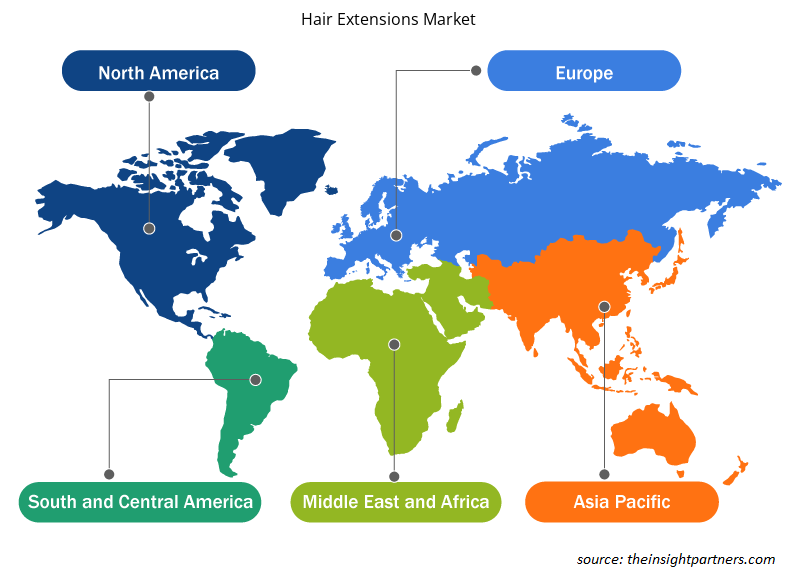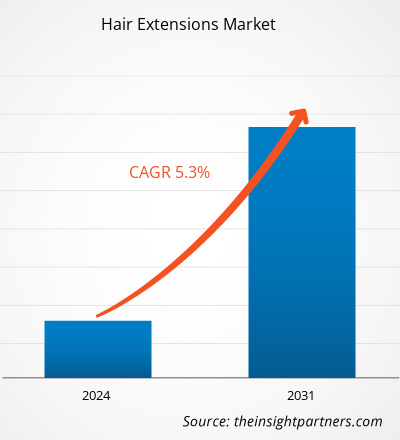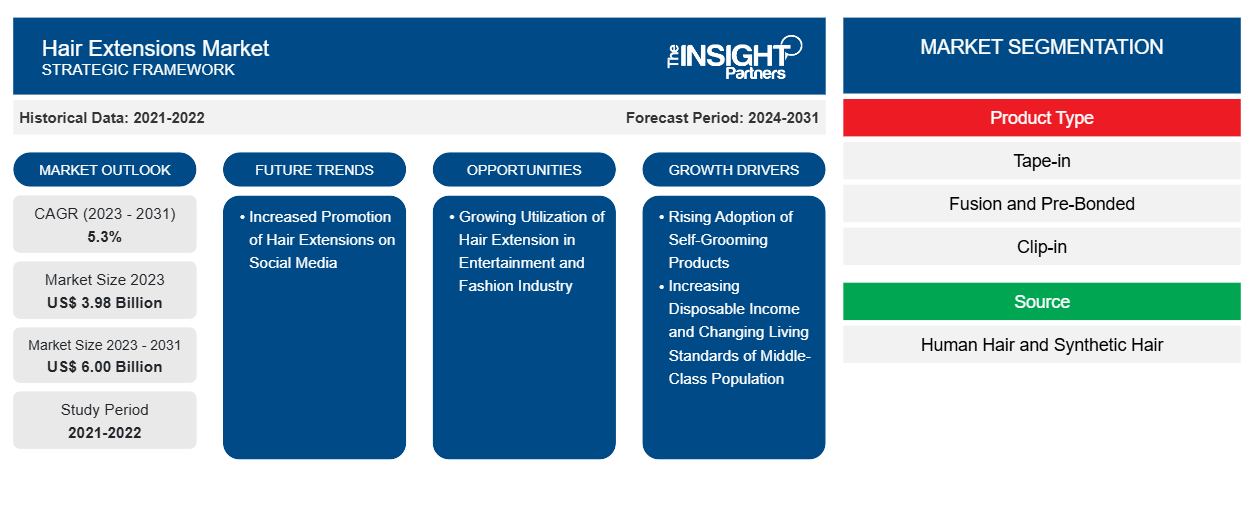Der Markt für Haarverlängerungen soll von 3,98 Milliarden US-Dollar im Jahr 2023 auf 6,00 Milliarden US-Dollar im Jahr 2031 anwachsen. Der Markt wird im Zeitraum 2023–2031 voraussichtlich eine durchschnittliche jährliche Wachstumsrate von 5,3 % verzeichnen. Die zunehmende Werbung für Haarverlängerungen auf Social-Media-Plattformen mit integrierten Einkaufsmöglichkeiten und Markenwerbung auf Instagram, Facebook und YouTube dürften weiterhin wichtige Trends auf dem Markt für Haarverlängerungen bleiben.CAGR of 5.3% during 2023–2031. Increasing promotion of hair extensions on social media platforms with integrated shopping facilities and brand endorsements on Instagram, Facebook, and YouTube are likely to remain key trends in the
Haarverlängerungen Marktanalyse
Eine allmähliche Umstellung der Verbraucher auf hochwertige und luxuriöse Körperpflegeprodukte, positive Auswirkungen der Körperpflege auf das Selbstwertgefühl und die soziale Interaktion, eine Verbesserung der Lebensqualität und eine steigende Zahl von Haarausfall treiben das Wachstum des Marktes für Haarverlängerungen voran. Die steigende Nachfrage nach Haarverlängerungen in der Mode- und Unterhaltungsbranche aufgrund der zunehmenden Vorliebe für Haarverlängerungen bei Models und Prominenten dürfte dem Markt in den kommenden Jahren potenzielle Chancen eröffnen.
Marktübersicht für Haarverlängerungen
Haarverlängerungen bestehen hauptsächlich aus menschlichem Haar oder Kunsthaar in unterschiedlicher Länge, Fülle und Farbe. Sie können individuell an die Wünsche des Kunden angepasst und von einem Friseur weiter gestylt werden. Beim Einklemmen der Haarverlängerungen wird die ursprüngliche Haarstruktur nicht gestört. Sie bieten eine schnelle Lösung, um Volumen zu verleihen und das Haar länger und voller aussehen zu lassen, ohne dass eine schmerzhafte Haartransplantation erforderlich ist. Angesichts des steigenden verfügbaren Einkommens und des verbesserten Lebensstandards sowie des boomenden Modeeinzelhandels wird erwartet, dass der Markt für Haarverlängerungen in den kommenden Jahren weiter florieren wird.
Passen Sie diesen Bericht Ihren Anforderungen an
Sie erhalten kostenlose Anpassungen an jedem Bericht, einschließlich Teilen dieses Berichts oder einer Analyse auf Länderebene, eines Excel-Datenpakets sowie tolle Angebote und Rabatte für Start-ups und Universitäten.
-
Holen Sie sich die wichtigsten Markttrends aus diesem Bericht.Dieses KOSTENLOSE Beispiel umfasst eine Datenanalyse von Markttrends bis hin zu Schätzungen und Prognosen.
Treiber und Chancen auf dem Markt für Haarverlängerungen
Steigende Akzeptanz von Körperpflegeprodukten begünstigt den Markt
Die sich ändernde Präferenz der Verbraucher hin zu luxuriösen und hochwertigen Körperpflegeprodukten aufgrund steigender verfügbarer Einkommen, zunehmender Kaufkraft, verbesserter Lebensgewohnheiten der Menschen und zunehmender Fälle von Haarausfall sind einige Faktoren, die das Wachstum des Marktes für Haarverlängerungen vorantreiben.
Europa und Nordamerika sind bedeutende Märkte für die Stylingbranche und machen zusammen mehr als 60 % des Kosmetikmarktes aus. Haarpflegeprodukte erfreuen sich bei den Verbrauchern großer Beliebtheit, da Haarausfall, Trockenheit, Volumenverlust und andere haarbezogene Probleme immer häufiger auftreten.
Afrikanische Verbraucher und Menschen afrikanischer Abstammung sind bedeutende Verbraucher von Haarverlängerungen. Studien zeigen, dass afrikanische Frauen bereit sind, doppelt so viel für Schönheits- und Haarprodukte auszugeben. Daher treibt die zunehmende Verwendung von Körperpflegeprodukten in der Weltbevölkerung den globalen Markt für Haarverlängerungen an.
Zunehmende Nutzung von Haarverlängerungen in der Unterhaltungs- und Modebranche
Aufgrund der steigenden Zahl von Alopeziefällen erfreuen sich Haarverlängerungen in der Unterhaltungs- und Modebranche großer Beliebtheit. Darüber hinaus wird die Nachfrage nach Haarverlängerungen in Ländern wie den USA hauptsächlich durch Promi-Trends bestimmt. Dieser Faktor beeinflusst die Gesamtbevölkerung und immer mehr Menschen verlangen nach Haarverlängerungsprodukten. Sunny's Hair & Wigs, ein Einzelhandelsgeschäft, hat seit seiner Gründung 1992 in Minneapolis kürzlich nach Phoenix und Atlanta expandiert. Es verfügt über einen großen Kundenstamm in der Unterhaltungsbranche.alopecia. Further, the demand for hair extensions in countries such as the US is mainly determined by celebrity trends. This factor influences the general population, and more people are demanding hair extension products. Recently, Sunny's Hair & Wigs, a retail store, has expanded to Phoenix and Atlanta since it started in Minneapolis in 1992. It has a vast client base in the entertainment industry.
Die Mode- und Unterhaltungsbranche ist für den Verkauf und die Einführung von Haarverlängerungsprodukten von entscheidender Bedeutung geworden. Produktions- und Modehäuser führen zahlreiche Haarverlängerungen für Models und Schauspieler, da diese herausragende Rollen und Charaktere spielen. Der Anstieg von Haarerkrankungen bei Verbrauchern trägt ebenfalls dazu bei, dass die Branche in gleichmäßigem Tempo wächst. Die Zahl der Personen, die unter Haarausfall leiden, steigt rapide an, weshalb sich viele Menschen für Haarverlängerungen entscheiden. Daher wird erwartet, dass diese Faktoren im Prognosezeitraum lukrative Möglichkeiten für das Wachstum des Haarverlängerungsmarktes schaffen.
Segmentierungsanalyse des Marktberichts für Haarverlängerungen
Wichtige Segmente, die zur Ableitung der Marktanalyse für Haarverlängerungen beigetragen haben, sind Typ, Quelle und Vertriebskanal.
- Nach Typ ist der Markt für Haarverlängerungen in Tape-In, Fusion und Pre-Bonded, Clip-In, Weft und andere unterteilt. Das Clip-In-Segment hatte 2023 den größten Marktanteil. Clip-In-Haarverlängerungen, auch Clip-In-Wefts genannt, sind gebrauchsfertige Produkte und die am wenigsten dauerhaften Verlängerungen, da sie leicht entfernt und bei Bedarf angebracht werden können. Das Anbringen von Clip-In-Haarverlängerungen dauert zu Hause normalerweise 5–15 Minuten. Dies sind die am wenigsten schädlichen Haarverlängerungen und enthalten keine Chemikalien, keinen Druck , keine Hitze und keine anderen Installationsmethoden. Daher treiben Vorteile wie die einfache Anwendung von Clip-In-Haarverlängerungen und weniger Schäden am natürlichen Haar die Nachfrage nach Clip-In-Haarverlängerungen an.pre-bonded, clip-in, weft, and others. The clip-in segment held the largest market share in 2023. Clip-in hair extensions, also called clip-in wefts, are ready to use products and are the least permanent extensions as these can be easily removed and applied whenever needed. Clip-in hair extension usually takes 5–15 minutes to apply at home. These are the least damaging hair extensions and do not have chemicals,
- Der Markt ist nach Herkunft in Echthaar und Kunsthaar unterteilt. Das Segment Kunsthaar hatte 2023 einen größeren Marktanteil. Kunsthaarverlängerungen sind günstiger als Echthaarverlängerungen, was die Nachfrage nach Kunsthaarverlängerungen voraussichtlich ankurbeln wird. Darüber hinaus kurbeln die Verfügbarkeit einer großen Vielfalt an Farben, Stilen und Längen, der geringe Pflegeaufwand und die kürzere Anwendungszeit von Kunsthaarverlängerungen ihre Nachfrage an.
- In Bezug auf die Vertriebskanäle ist der Markt in Supermärkte und Hypermärkte, Fachgeschäfte, Online-Einzelhandel und andere unterteilt. Das Segment der Fachgeschäfte hielt im Jahr 2023 einen erheblichen Marktanteil. Fachgeschäfte verfügen über Experten für Haarverlängerungen und bieten personalisierte Dienstleistungen an. Die Haarverlängerungsspezialisten in den Geschäften sind darin geschult, individuelle Bedürfnisse einzuschätzen, geeignete Produkte zu empfehlen und professionelle Installations- und Wartungsdienste anzubieten. Dieses Maß an Fachwissen schafft Vertrauen bei den Kunden, sorgt für ein besseres Ergebnis und verringert das Risiko von Schäden oder falscher Anwendung.
Marktanteilsanalyse für Haarverlängerungen nach Geografie
Der geografische Umfang des Marktberichts für Haarverlängerungen ist hauptsächlich in fünf Regionen unterteilt: Nordamerika, Asien-Pazifik, Europa, Naher Osten und Afrika sowie Süd- und Mittelamerika.
Nordamerika dominierte den Markt für Haarverlängerungen im Jahr 2023. Die Nachfrage nach Haarverlängerungen in Nordamerika ist aufgrund wachsender Modetrends der Prominenten und erhöhter Pflege- und Schönheitsaktivitäten stark angestiegen. Kaukasische Verbraucher verwenden Haarprodukte normalerweise aus kosmetischen Gründen oder um ein bestimmtes Modeimage zu schaffen. Kaukasische Verbraucher kommen hauptsächlich aus Nordamerika und Europa und haben im Allgemeinen ein höheres Einkommen als Kunden in anderen Regionen. Sie achten auch mehr auf die Qualität ihrer Haarprodukte, was die Nachfrage nach Produkten aus Echthaar ansteigen lässt. Zunehmender Haarausfall ist ein weiterer wichtiger Faktor, der das Wachstum des Marktes für Haarverlängerungen ankurbelt. Verbraucher in Nordamerika konzentrieren sich hauptsächlich auf die Verwendung fortschrittlicher Formen von Haarverlängerungen. Hersteller in der Region investieren stark in die Forschung und Entwicklung von Haarverlängerungen, was den Markt in Nordamerika voraussichtlich ankurbeln wird. In den letzten 15 Jahren war Cinderella Hair führend bei der Innovation von vorgebundenen Haarverlängerungen und bietet feinste Schuppenschicht aus 100 % Remy-Menschenhaar.pre-bonded hair extension innovation, providing the finest cuticle 100% Remy human hair.
Regionale Einblicke in den Markt für Haarverlängerungen
Die regionalen Trends und Faktoren, die den Markt für Haarverlängerungen im Prognosezeitraum beeinflussen, wurden von den Analysten von Insight Partners ausführlich erläutert. In diesem Abschnitt werden auch die Marktsegmente und die Geografie für Haarverlängerungen in Nordamerika, Europa, im asiatisch-pazifischen Raum, im Nahen Osten und Afrika sowie in Süd- und Mittelamerika erörtert.

- Holen Sie sich die regionalen Daten für den Markt für Haarverlängerungen
Umfang des Marktberichts für Haarverlängerungen
| Berichtsattribut | Details |
|---|---|
| Marktgröße im Jahr 2023 | 3,98 Milliarden US-Dollar |
| Marktgröße bis 2031 | 6,00 Milliarden US-Dollar |
| Globale CAGR (2023 - 2031) | 5,3 % |
| Historische Daten | 2021-2022 |
| Prognosezeitraum | 2024–2031 |
| Abgedeckte Segmente |
Nach Produkttyp
|
| Abgedeckte Regionen und Länder |
Nordamerika
|
| Marktführer und wichtige Unternehmensprofile |
|
Dichte der Marktteilnehmer für Haarverlängerungen: Die Auswirkungen auf die Geschäftsdynamik verstehen
Der Markt für Haarverlängerungen wächst rasant, angetrieben durch die steigende Nachfrage der Endverbraucher aufgrund von Faktoren wie sich entwickelnden Verbraucherpräferenzen, technologischen Fortschritten und einem größeren Bewusstsein für die Vorteile des Produkts. Mit steigender Nachfrage erweitern Unternehmen ihr Angebot, entwickeln Innovationen, um die Bedürfnisse der Verbraucher zu erfüllen, und nutzen neue Trends, was das Marktwachstum weiter ankurbelt.
Die Marktteilnehmerdichte bezieht sich auf die Verteilung der Firmen oder Unternehmen, die in einem bestimmten Markt oder einer bestimmten Branche tätig sind. Sie gibt an, wie viele Wettbewerber (Marktteilnehmer) in einem bestimmten Marktraum im Verhältnis zu seiner Größe oder seinem gesamten Marktwert präsent sind.
Die wichtigsten auf dem Markt für Haarverlängerungen tätigen Unternehmen sind:
- Schlösser & Fesseln
- Klix Hair Inc
- Easihair Pro.
- Balmain Hair Group BV
- Große Längen SpA
- Evergreen Products Group GmbH
Haftungsausschluss : Die oben aufgeführten Unternehmen sind nicht in einer bestimmten Reihenfolge aufgeführt.

- Überblick über die wichtigsten Akteure auf dem Markt für Haarverlängerungen
Neuigkeiten und aktuelle Entwicklungen zum Markt für Haarverlängerungen
Der Markt für Haarverlängerungen wird durch die Erhebung qualitativer und quantitativer Daten nach Primär- und Sekundärforschung bewertet, die wichtige Unternehmensveröffentlichungen, Verbandsdaten und Datenbanken umfasst. Nachfolgend sind einige der Entwicklungen auf dem Markt für Haarverlängerungen aufgeführt:
- Diva Divine Hair, Indiens erster Premium-Händler für Haarverlängerungen und Perücken seit 2008, hat eine neue Reihe preisgünstiger und hochwertiger Produkte wie Clip-in-Haarverlängerungen, Haarteile, Perücken und Haar-Accessoires auf den Markt gebracht. Die von Diva Divine angebotenen Produkte bestehen zu 100 % aus natürlichem Menschenhaar. Das Unternehmen gab bekannt, dass seine Clip-in-Haarverlängerungen einfach zu verwenden sind und sofort für mehr Haarlänge und -volumen sorgen. Es erwähnte auch, dass seine Haarteile in verschiedenen Formen und Größen erhältlich sind und Perücken einfach anzubringen sind und ein natürliches Aussehen verleihen. (Quelle: Hindustan Times, Newsletter, Juli 2022)
- Das Haarverlängerungsunternehmen Bellami hat Bellami Professional Hair Care auf den Markt gebracht, die weltweit erste professionelle Haarverlängerungspflegekollektion für den Einsatz im Salon und zu Hause. (Happi, Newsletter, Oktober 2023)
Marktbericht zu Haarverlängerungen – Umfang und Ergebnisse
Der Bericht „Marktgröße und Prognose für Haarverlängerungen (2020–2031)“ bietet eine detaillierte Analyse des Marktes, die die folgenden Bereiche abdeckt:
- Marktgröße und Prognose für Haarverlängerungen auf globaler, regionaler und Länderebene für alle wichtigen Marktsegmente, die im Rahmen des Berichts abgedeckt sind
- Markttrends für Haarverlängerungen sowie Marktdynamiken wie Treiber, Einschränkungen und wichtige Chancen
- Detaillierte PEST/Porters Five Forces- und SWOT-Analyse
- Marktanalyse für Haarverlängerungen, die wichtige Markttrends, globale und regionale Rahmenbedingungen, wichtige Akteure, Vorschriften und aktuelle Marktentwicklungen umfasst
- Branchenlandschaft und Wettbewerbsanalyse, einschließlich Marktkonzentration, Heatmap-Analyse, prominenten Akteuren und aktuellen Entwicklungen auf dem Markt für Haarverlängerungen
- Detaillierte Firmenprofile
- Historische Analyse (2 Jahre), Basisjahr, Prognose (7 Jahre) mit CAGR
- PEST- und SWOT-Analyse
- Marktgröße Wert/Volumen – Global, Regional, Land
- Branchen- und Wettbewerbslandschaft
- Excel-Datensatz
Aktuelle Berichte
Verwandte Berichte
Erfahrungsberichte
Grund zum Kauf
- Fundierte Entscheidungsfindung
- Marktdynamik verstehen
- Wettbewerbsanalyse
- Kundeneinblicke
- Marktprognosen
- Risikominimierung
- Strategische Planung
- Investitionsbegründung
- Identifizierung neuer Märkte
- Verbesserung von Marketingstrategien
- Steigerung der Betriebseffizienz
- Anpassung an regulatorische Trends























 Kostenlose Probe anfordern für - Markt für Haarverlängerungen
Kostenlose Probe anfordern für - Markt für Haarverlängerungen